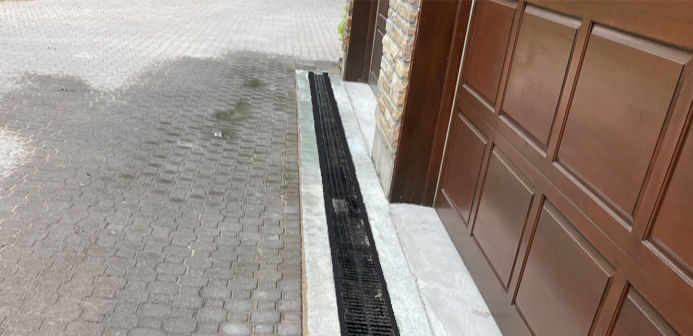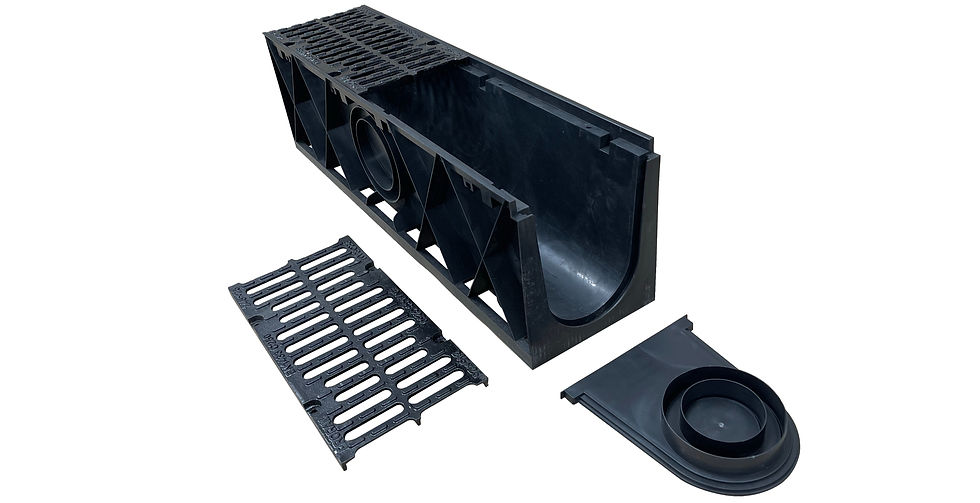French Drain, Trench Drain and Other Drainage Solutions: Which Is Best for Your Property?
- Proram

- Apr 28
- 7 min read
Updated: May 12

Water is one of your property's greatest hidden threats. Whether it’s pooling around your foundation, flooding your yard, or seeping into your basement, poor drainage can cause thousands of dollars in damage if left unchecked. That's why investing in the right drainage system isn't just a good idea: it's essential for protecting your home or business.
But when it comes to drainage solutions, not all systems are created equal. French drains, linear drains, sump pumps, and catch basins each offers different advantages depending on your property's layout, soil type, and water challenges.
In this article, we’ll break down the key differences between a French drain and other drainage options, so you can make an informed choice and keep your property safe, dry, and protected for years to come.
What Is a French Drain?
A French drain is one of the most effective and time-tested solutions for managing excess water on your property. Despite its name, it has nothing to do with France, it was actually named after Henry Flagg French (1813-1885), an American agriculturist, who popularized the concept in the 19th century. Read more about French drains here.

A French drain is essentially a sloped trench filled with gravel or rock, containing a perforated pipe that redirects water away from areas prone to flooding or pooling. Water naturally follows the path of least resistance, so when the soil becomes saturated, it flows into the gravel trench, enters the perforated pipe, and is carried safely away from your foundation, yard, or low-lying areas.
Key Features of a French Drain:
Subsurface installation (hidden underground)
Perforated pipe system for water redirection
Gravel or rock layers to encourage water flow and filtration
Ideal for managing groundwater and preventing foundation damage
Common Uses of a French Drain:
Protecting home foundations from water infiltration
Eliminating soggy lawns and flooded gardens
Reducing hydrostatic pressure against basement walls
Preventing erosion on sloped properties
Why Homeowners Love French Drains:
Highly effective for persistent drainage issues
Discreet and invisible once installed
Long-lasting with minimal maintenance when properly built
When planned and installed correctly, a French drain is an excellent investment that can dramatically improve the health and stability of your property’s soil, structures, and landscaping.
What Is a Linear Drain or Trench drain?
A linear drain, sometimes called a trench drain or channel drain, is another popular drainage solution, especially for areas that require fast surface water management. Unlike a French drain that handles subsurface water, a linear drain captures and redirects water flowing over the surface.

A linear drain consists of a long, narrow channel covered by a slotted or grated surface. Water flows directly into the channel and is carried away through an underground piping system. You’ve likely seen linear drains in action around swimming pools, driveways, commercial entrances, and even in luxury showers.
Key Features of a Trench Drain:
Surface-mounted system with visible grate covers
Designed for high-capacity water collection
Often made from durable materials like stainless steel, concrete, or polymer
Available in various load ratings (like C250 for medium to heavy traffic areas)
Common Uses:
Managing water runoff on driveways, patios, and parking lots
Preventing water pooling around building entrances
Enhancing surface drainage in landscaping and hardscaping projects
Used indoors for sleek, modern shower designs
Imagine a sloped driveway where rainwater tends to rush toward the garage. Without proper drainage, this water could flood the garage or damage the building’s foundation. A linear drain installed across the width of the driveway collects the surface water immediately and channels it safely away, protecting both the structure and the surrounding property.
As such, property owners often prefer linear drains because they are highly efficient for heavy rain and surface runoff, they are modern with discreet design options and provide easy access for maintenance and cleaning.
At PRORAM, we specialize in the installation of industrial-grade C250 linear drains, engineered for medium to heavy-duty applications such as commercial parking lots, busy driveways, and industrial entrances.
These high-performance C250 linear drains are also perfectly suited for residential projects, including patios, gardens, and driveways in front of garages, offering the same level of durability and efficient water management.

Our C250 linear drains are built for strength and durability, capable of withstandig the weight of vehicles and high foot traffic without compromising water flow performance.
With robust construction and precision installation, PRORAM’s C250 linear drains ensure long-lasting protection, efficient surface water management, and low-maintenance operation for all types of properties.
While French drains tackle underground water issues, linear drains are the go-to choice for controlling surface water before it has a chance to seep into the ground and cause problems.
Other Common Drainage Solutions
While French drains and linear drains are two of the most trusted options, they aren't the only drainage solutions available. Depending on your property's needs, other systems might be used alone or combined with them for even better protection.
Here’s a quick overview of other common drainage methods:
Catch Basins
A catch basin is a type of drainage box set into the ground to "catch" water runoff. It typically features a grate on top and connects to a drainage pipe underneath.

Sump Pumps
Sump pumps are mechanical devices installed in a pit inside a basement or crawlspace. They pump groundwater out and away from the building when water levels rise.

Swales
A swale is a shallow, grassy channel designed to direct rainwater runoff naturally across a landscape.

Grading and Sloping
Proper grading simply means shaping your land so water flows away from structures instead of pooling around them. Sometimes, improving your property’s slope is enough to prevent water issues without installing new systems.

Trench Drains
Trench drains are very similar to linear drains, but are typically larger and designed for extremely high water volumes, like in industrial facilities or airports.

French Drain Versus Other Solutions: Detailed Comparison
Choosing the right drainage system isn’t always obvious. Each solution comes with its own strengths, limitations, and ideal use cases. Let’s break it down clearly so you can see which option might best fit your property’s needs.
Here’s a simple side-by-side comparison:
Key Takeaways:
French drains are ideal if you’re fighting moisture that comes up from the ground, especially near basements, foundations, or in yards with poor drainage.
Linear drains are perfect when surface water is your main concern. Think driveways, patios, and entranceways where water flows across hard surfaces.
Catch basins and sump pumps are critical in areas prone to heavy storms or high groundwater levels.
Grading and swales are more preventive measures that are best combined with another solution if you have serious water issues.
Trench drains are specialized and usually unnecessary for typical residential use unless dealing with unusually heavy runoff.
Curtain drains are best for shallow groundwater problems. They work by blocking water before it reaches structures but aren’t suited for managing deep or high-volume water flow.
How to Choose the Right Drainage System for Your Property
With so many options available, from French drains to linear drains and beyond, how do you know which solution is right for you? The answer depends on a few key factors specific to your property:
Source of the Water Problem
Surface water (rainwater flowing across hardscapes)? → A linear drain or catch basin might be ideal.
Subsurface water (groundwater saturating the soil)? → A French drain is likely the better choice.
Interior water issues (wet basements or crawlspaces)? → A sump pump system might be needed alongside proper exterior drainage.
Property Layout and Slope
Properties with natural slopes may benefit from swales or properly directed French drains.
Flat properties or those near water bodies may need more engineered systems like sump pumps or multiple drains working together.
Soil Type
Clay-heavy soils retain water longer and typically require more aggressive drainage solutions.
Sandy soils drain naturally but can still cause issues during heavy storms if the surface runoff isn't managed.
Budget and Project Scope
Simple grading adjustments might solve minor issues at a lower cost.
For serious drainage problems, investing in a complete system like a French drain or a combination of solutions protects your property's value in the long term.
Work with Trusted Drain Solution Experts
Every property is unique, and the right drainage solution is rarely a one-size-fits-all decision.
At PRORAM, we specialize in evaluating your specific challenges and recommending the most effective, durable solution tailored to your needs.
Whether you’re considering a French drain, linear drain, or a customized drainage system, we’re here to help protect your investment and give you peace of mind.
➡️ Call us today for a consultation and expert advice on drainage installations for residential, commercial, or industrial properties, or to learn more about our C250 industrial-grade linear drains.

